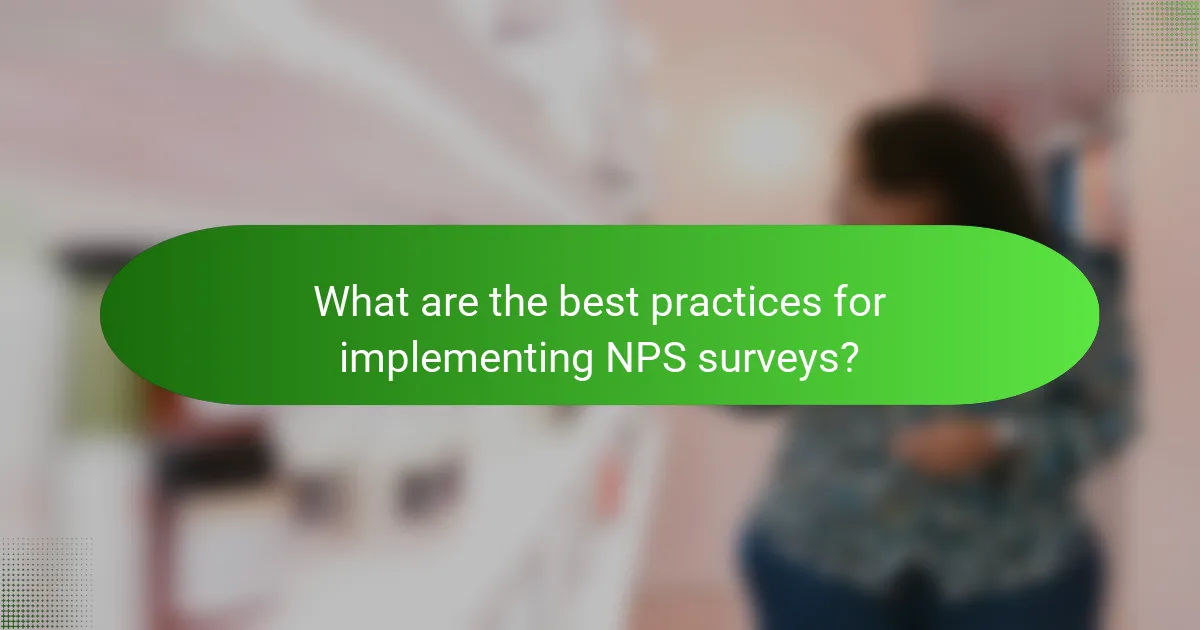Brand loyalty is a crucial factor for business success, and measuring it effectively can provide valuable insights. The Net Promoter Score (NPS) is a widely used tool that gauges customer willingness to recommend a brand, helping businesses identify loyal customers and areas needing improvement. By implementing well-designed NPS surveys and analyzing the results, companies can enhance customer experience and strengthen their brand loyalty strategies.

How to measure brand loyalty using Net Promoter Score?
To measure brand loyalty with the Net Promoter Score (NPS), businesses survey customers to determine their likelihood of recommending the brand to others. This score helps identify loyal customers and areas for improvement.
Definition of Net Promoter Score
The Net Promoter Score is a metric used to gauge customer loyalty by asking one key question: “On a scale from 0 to 10, how likely are you to recommend our product/service to a friend or colleague?” Based on their responses, customers are categorized into three groups: promoters (9-10), passives (7-8), and detractors (0-6).
The NPS is calculated by subtracting the percentage of detractors from the percentage of promoters. This results in a score that can range from -100 to +100, providing a clear indication of overall customer sentiment towards the brand.
Importance of measuring brand loyalty
Measuring brand loyalty through NPS is crucial because it provides insights into customer satisfaction and potential growth. A high NPS indicates a strong base of loyal customers who are likely to advocate for the brand, leading to increased referrals and sales.
Additionally, tracking NPS over time allows businesses to identify trends and assess the impact of changes in products or services. This ongoing feedback loop can inform strategic decisions and enhance customer experience.
Key metrics derived from NPS
Key metrics derived from NPS include the overall NPS score, the percentage of promoters, passives, and detractors, and trends over time. These metrics help businesses understand customer loyalty dynamics and identify areas needing attention.
Furthermore, segmenting NPS by customer demographics or purchase behavior can provide deeper insights. For example, a company may find that younger customers have a higher NPS, indicating a need to tailor marketing strategies to engage different audience segments effectively.

What are the best practices for implementing NPS surveys?
To effectively implement Net Promoter Score (NPS) surveys, focus on clear design, appropriate timing, and targeted audience segmentation. These practices help ensure that the feedback collected is actionable and relevant to your brand’s loyalty efforts.
Survey design tips
Designing an effective NPS survey involves crafting clear and concise questions. The core question should ask respondents how likely they are to recommend your brand on a scale of 0 to 10. Follow this with open-ended questions to gather qualitative insights about their experiences.
Keep the survey short, ideally under five questions, to encourage completion. Use simple language and avoid jargon to ensure that all respondents understand the questions easily.
Timing and frequency of surveys
Timing is crucial for obtaining meaningful NPS feedback. Conduct surveys shortly after a customer interaction, such as a purchase or customer service call, to capture their immediate impressions. This approach increases the likelihood of receiving relevant and timely responses.
As for frequency, avoid overwhelming customers with too many surveys. A good practice is to survey customers every six months or after significant interactions, ensuring you gather insights without causing survey fatigue.
Target audience segmentation
Segmenting your audience is essential for gaining deeper insights from your NPS surveys. Consider factors such as customer demographics, purchase history, and engagement levels. This allows you to tailor your questions and analyze results based on specific customer groups.
By understanding the different segments, you can identify trends and areas for improvement that may not be apparent in aggregate data. For example, loyal customers may provide different feedback compared to new customers, highlighting distinct opportunities for enhancing brand loyalty.

How to analyze Net Promoter Score results?
Analyzing Net Promoter Score (NPS) results involves interpreting the data to understand customer loyalty and satisfaction. This process helps businesses identify strengths and weaknesses in their offerings, guiding improvements and strategies for enhancing customer experience.
Interpreting NPS data
Interpreting NPS data requires understanding the score itself, which ranges from -100 to 100. A positive score indicates more promoters than detractors, while a negative score suggests the opposite. Generally, a score above 50 is considered excellent, while scores below 0 are concerning.
Look for trends over time to gauge customer sentiment. A consistent increase in NPS may indicate successful initiatives, while a decline could signal emerging issues that need immediate attention.
Identifying promoters, passives, and detractors
To identify promoters, passives, and detractors, categorize respondents based on their scores. Promoters (scores of 9-10) are loyal customers likely to recommend your brand, while passives (scores of 7-8) are satisfied but unenthusiastic. Detractors (scores of 0-6) are unhappy customers who can harm your brand’s reputation.
Understanding these groups allows businesses to tailor their strategies. For instance, engage promoters with loyalty programs, address the concerns of detractors, and convert passives into promoters through targeted outreach.
Benchmarking against industry standards
Benchmarking your NPS against industry standards provides context for your score. Different industries have varying average NPS scores; for example, technology companies often see scores in the range of 30-50, while hospitality may average higher. Research industry reports to find relevant benchmarks.
Use these benchmarks to set realistic goals for improvement. If your score is below the industry average, identify specific areas for enhancement and track progress over time to ensure you are moving in the right direction.

What actions can be taken based on NPS feedback?
Organizations can take several actions based on Net Promoter Score (NPS) feedback to enhance customer loyalty and satisfaction. By analyzing the feedback from promoters and detractors, businesses can implement targeted strategies to improve their offerings and customer experience.
Strategies to convert detractors
To convert detractors into promoters, businesses should first identify the specific reasons behind their dissatisfaction. This can be achieved through follow-up surveys or direct conversations, which can reveal pain points that need addressing.
Once the issues are identified, prioritize actionable changes that can make a significant impact. For example, if customers express frustration with customer service response times, consider investing in training or additional staff to improve efficiency. Regularly communicate improvements to detractors to show that their feedback is valued.
Enhancing customer experience for promoters
Promoters are already satisfied customers who can provide valuable insights into what works well. Engage with them through loyalty programs or exclusive offers to reinforce their positive experience. This can include early access to new products or special discounts.
Additionally, actively seek their feedback on potential improvements or new offerings. This not only strengthens their loyalty but also makes them feel like part of the brand’s community, encouraging them to share their positive experiences with others.
Using feedback for product development
NPS feedback can be a goldmine for product development. By analyzing comments from both promoters and detractors, companies can identify trends and preferences that inform future product enhancements or new features. For instance, if multiple customers suggest a specific feature, it may be worth considering for the next product iteration.
Incorporate a structured process for reviewing NPS feedback regularly, ensuring that insights are shared across relevant teams. This collaborative approach can lead to more innovative solutions that align with customer expectations, ultimately driving higher satisfaction and loyalty.

What are the limitations of Net Promoter Score?
Net Promoter Score (NPS) has several limitations that can affect its reliability as a measure of brand loyalty. While it provides a quick snapshot of customer sentiment, it may not capture the full complexity of customer experiences or the reasons behind their loyalty or disloyalty.
Potential biases in NPS
One major limitation of NPS is the potential for biases in responses. Customers who feel strongly—either positively or negatively—are more likely to respond, leading to skewed results. Additionally, cultural differences can influence how respondents interpret the scoring system, which may not be consistent across different regions.
Another bias arises from the survey methodology itself. If NPS surveys are conducted immediately after a purchase or interaction, they may not reflect long-term loyalty but rather short-term satisfaction. This can mislead businesses about their actual customer loyalty levels.
Contextual factors affecting results
Context plays a crucial role in NPS outcomes. Factors such as the timing of the survey, the specific customer segment targeted, and external market conditions can all impact scores. For instance, a company may receive higher NPS scores during a product launch compared to a period of service disruption.
Moreover, the industry in which a business operates can also affect NPS. For example, industries with high competition may see lower scores due to customer expectations, while niche markets might yield higher loyalty scores due to less choice.
Alternatives to NPS for measuring loyalty
While NPS is widely used, there are several alternatives that can provide a more nuanced view of customer loyalty. Customer Satisfaction Score (CSAT) measures satisfaction with a specific interaction, while Customer Effort Score (CES) assesses how easy it is for customers to engage with a brand.
Additionally, qualitative methods such as customer interviews or focus groups can uncover deeper insights into customer motivations and feelings. Combining quantitative and qualitative approaches often yields a more comprehensive understanding of loyalty, allowing businesses to tailor their strategies effectively.

How does NPS compare to other loyalty metrics?
Net Promoter Score (NPS) offers a unique perspective on brand loyalty compared to other metrics like Customer Satisfaction Score (CSAT) and Customer Effort Score (CES). While NPS focuses on the likelihood of customers recommending a brand, CSAT measures satisfaction with specific interactions, and CES evaluates the ease of customer experiences.
Comparison with Customer Satisfaction Score
Customer Satisfaction Score (CSAT) gauges how satisfied customers are with a product or service at a particular moment. Typically measured on a scale from 1 to 5 or 1 to 10, CSAT provides immediate feedback but may not fully capture long-term loyalty. For example, a customer might be satisfied with a purchase but not necessarily loyal to the brand.
In contrast, NPS assesses overall loyalty by asking customers how likely they are to recommend the brand to others. This broader perspective can reveal deeper insights into customer relationships, as a high CSAT score does not guarantee that customers will promote the brand.
Comparison with Customer Effort Score
Customer Effort Score (CES) measures how easy it is for customers to interact with a brand, focusing on the effort required to resolve issues or complete transactions. A lower CES indicates a smoother experience, which can enhance customer loyalty. However, CES does not directly measure emotional attachment or willingness to recommend, which are crucial for long-term loyalty.
NPS complements CES by providing insight into the emotional connection customers have with a brand. While CES can highlight areas for operational improvement, NPS captures the overall sentiment that drives customer advocacy. Brands should consider using both metrics together for a comprehensive view of customer loyalty.
